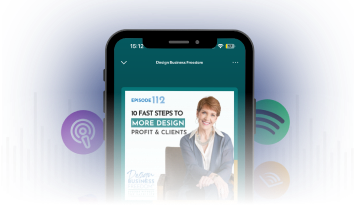10 Big Little Mistakes Sabotaging Your Design Success
As interior designers, we spend a lot of time perfecting our craft, but sometimes it’s the little things that can hold back our business growth. From the way we present ourselves online to the channels we use to communicate, small oversights can make a big difference. Below are ten mistakes sabotaging your design success you might not realize are getting in the way of your success.
Episode Timestamps
- (01:48) Missing phone number costs you clients
- (04:59) Location info is essential for your site and social media
- (06:53) Not listing an email address is a big mistake
- (10:50) Lacking your name or identity hurts your brand
- (13:52) Claiming your Google My Business listing is crucial
- (16:06) Social media is a valuable search engine for designers
- (19:28) Inactive social media and blog content damages your credibility
- (23:45) Using your face over a logo strengthens your brand
- (28:13) A missing footer on your site is a critical error
- (29:33) No portfolio on your website is a deal-breaker
1. No Phone Number on Your Website
In this digital age, it’s tempting to rely solely on email or social media for inquiries. But not having a phone number on your website could be costing you clients. Some people still prefer the personal touch of a phone call, and if they can’t find your number, they might move on to someone else. This is especially true for older clients or those who experience a technical glitch with your online inquiry form. Consider using a secondary phone number app if privacy is a concern.
2. No Location Listed
It’s surprising how many designers fail to list their city or state in their Instagram bio or website—one of the common mistakes sabotaging your design success. Potential clients want to know where you’re based, especially for time zone considerations. Listing your location doesn’t mean you’re limited to local projects, but it helps establish credibility. Plus, clients searching for a local designer are more likely to find you if your location is visible.
3. No Email Address
Forms are great for capturing leads, but they shouldn’t be the only way for people to contact you. Some clients or businesses may prefer to reach out via email for a quick inquiry. Plus, a personal or team-specific email (rather than “info@”) feels more professional and approachable.
4. No Name on Your Website
It might sound odd, but some designers forget to include their own name on their website—another one of the mistakes sabotaging your design success. Clients want to know who they’re working with, especially if you’re the face of your business. Make sure your name is prominently displayed, and if you have a team, consider including a brief bio for each member to build rapport with potential clients.

5. No Google My Business Listing
Your business might already be listed on Google, but if you haven’t claimed it, you’re missing out on a key opportunity to control your brand. A Google listing helps clients find you easily, provides reviews, shows your business hours, and more. Claim it, optimize it, and keep it updated.
6. No Social Media Presence
Social media isn’t just about posting pretty pictures—it’s a powerful search engine. People might not remember your website URL, but they’ll search for you on Instagram or Facebook. Having an active profile, even with minimal posts, shows potential clients that you’re current and engaged. It can be the difference between someone reaching out or moving on.
7. No Current Content on Social Media or Blog
IIt’s important to keep your content fresh. If your last post was six months ago, potential clients may assume you’re no longer active—one of the mistakes sabotaging your design success. One trick is to turn off dates on your blog posts, so older but still relevant content appears current. This helps keep your website looking updated without needing constant new posts.
8. No Face on Your Social Media Avatar
Your brand is personal, and clients want to connect with you. Using your logo as your profile picture is fine for a major brand, but people are more likely to engage with a person than a logo. A close-up of your smiling face in your profile picture can make a huge difference in attracting clients.
9. No Footer on Your Website
A footer is like a mini business card on your website. It should include key information like your contact details, social media links, and even a lead magnet (an offer or freebie to capture emails). Don’t make visitors scroll all the way back up to find what they need—make it easy for them.
10. No Portfolio
Even if you’re just starting out or don’t have many completed projects, it’s essential to showcase some form of portfolio. A collection of your work, whether it’s real or rendered, gives potential clients a sense of what you can do. If you’re struggling to create a portfolio, consider using before-and-after visuals, even if they’re digitally created.
Key Takeaways
These small fixes can make a big impact on how potential clients perceive you. Ignoring them is one of the subtle mistakes sabotaging your design success. Taking a couple of hours to address these issues will help you look more professional and accessible, leading to more inquiries and ultimately, more business.
When you’re ready to increase your interior design practice profits, work exclusively with ideal clients, and enjoy the time and resources for your extraordinary life, explore your coaching options. We’ve got your back in the business of interior design.





